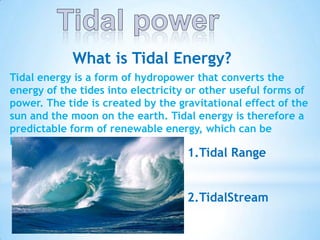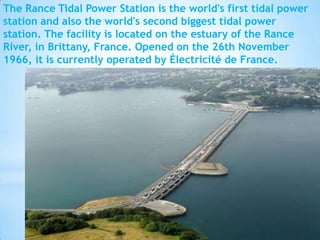Tidal energy
- 1. What is Tidal Energy? Tidal energy is a form of hydropower that converts the energy of the tides into electricity or other useful forms of power. The tide is created by the gravitational effect of the sun and the moon on the earth. Tidal energy is therefore a predictable form of renewable energy, which can be harnessed in two forms: 1.Tidal Range 2.TidalStream
- 2. Basic physics of tides •Gravitational pull of the sun and moon and the pull of the centrifugal force of rotation of the earth-moon system. • • •When a landmass lines up with the earth-moon system, the water around it is at high tide. •When a landmass is at 90 ͦ to the earth-moon system, the water around it is at low tide. • • There are two high tides and two low tides during each period of rotation of the earth. Spring and Neap tides depend on the orientation of the sun, moon, and the earth. ▫ High spring tides occur when the sun and moon line up with the earth. This occurs whether they are either on same or opposite side. ▫ Low neap tides occur when the sun and moon line up at 90 ͦ to each other. Flood Currents: currents moving in the direction of the coast. Ebb Currents: the current receding from the coast
- 3. Tidal Range Tidal Range is the vertical difference between the high tide and the succeeding low tide. Tides are the rise and fall of sea levels caused by the combined effects of the gravitational forces exerted by the moon and the sun and the rotation of the Earth. The tidal range is not constant, but changes depending on the relative positions of the Earth, sun and moon. Barrages and lagoons use this potential energy component of the tide to generate energy
- 4. Tidal Stream Tidal Stream is the flow of water as the tide ebbs and floods, and manifests itself as tidal current. Tidal stream devices seek to extract energy from this kinetic movement of water, much as wind turbines extract energy from the movement of air. The sea currents created by movement of the tides are often magnified where water is forced to flow through narrow channels or around headlands. There are a number of locations around the coastline of the UK where the tidal stream resource is high, and it is in these areas where early technology developments are taking place to explore the prospect of realizing the energy.
- 5. Although not yet widely used, tidal power has potential for future electricity generation. Tides are more predictable than wind energy and solar power. Among sources of renewable energy, tidal power has traditionally suffered from relatively high cost and limited availability of sites with sufficiently high tidal ranges or flow velocities, thus constricting its total availability. However, many recent technological developments and improvements, both in design indicate that the total availability of tidal power maybe much higher than previously assumed, and that economic and environmental costs may be brought down to competitive levels.
- 6. The Rance Tidal Power Station is the world's first tidal power station and also the world's second biggest tidal power station. The facility is located on the estuary of the Rance River, in Brittany, France. Opened on the 26th November 1966, it is currently operated by Électricité de France.
- 7. The Annapolis Royal Generating Station is a 20 MW tidal power station located on the Annapolis River immediately upstream from the town of Annapolis Royal, Nova Scotia, Canada. It is the only tidal generating station in North America. The generating station harnesses the tidal difference created by the large tides in the Annapolis Basin, a sub-basin of the Bay of Fundy. Opened in 1984, the Annapolis Royal Generating Station was constructed by Nova Scotia Power Corporation.
- 8. Tidal power issues Ecological Tidal power can have effects on marine life. The turbines can accidentally kill swimming sea life with the rotating blades. Some fish may no longer utilize the area if they were threatened with a constant rotating object. Corrosion Salt water causes corrosion in metal parts. It can be difficult to maintain tidal stream generators due to their size and depth in the water. Mechanical fluids, such as lubricants, can leak out, which may be harmful to the marine life nearby. Proper maintenance can minimize the amount of harmful chemicals that may enter the environment









